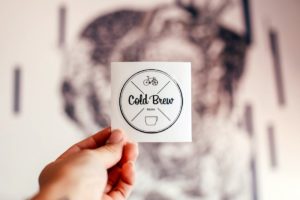Have you ever wondered how to make a better coffee with AeroPress?
Brewing good coffee is not nuclear science. You only need the right equipment, a little gray matter, and the proper instructions.
Here is all you need to know to make a great cup of coffee using AeroPress.
I’ll guide you through the process.
By Jozo Salmanić – Croatian barista with 15 years of experience.
Affiliate disclosure
This page may contain affiliate links – we may earn a small commission when you make a purchase through these links. This is at no extra cost to you.
How To Make The Best Coffee With AeroPress
Proper preparation gets most of the work done.
Apart from your AeroPress machine, you will need a few more things to make the best coffee.
The Electric Kettle Is The Best Choice
The kettle is the quickest way to boil water for your tea or coffee.
The more admirable models have temperature control, so you can hit that sweet spot for perfect coffee extraction (195 – 205˚ F).
A gooseneck kettle with a built-in thermometer would be the best choice.
You can also use a regular kettle, and check the water temperature with a kitchen thermometer.
In the last case scenario, you can boil water using any means necessary, from the campfire to your stove. Then just let it cool for around 15 seconds. That will give you a satisfying temperature.
A Burr Grinder Is A Must-Have
The AeroPress excels when you use a medium-fine grind.
This method also allows some variations, and you can use fine or even medium coarse grind.
However, you will have to adjust the brewing time accordingly.
A good burr grinder is a must for all your coffee recipes.
If you still don’t have one, grind your coffee on the spot when you buy it, and keep it in an airtight jar, far away from water, air, sun, and temperature extremes.
Pre-ground coffee in supermarkets is ground for espresso (fine grind).
However, you can use it for AeroPress in times of need.
Get A Small, Precise Kitchen Scale
The kitchen scale is one of the crucial parts of your coffee equipment.
Precise weighing coffee and water allows you to adjust and recreate your recipes.
It is also one of the cheapest parts of your coffee equipment, so there is no reason not to have it.
Still no kitchen scale? Together with AeroPress, you will get a funny-looking spoon.
That spoon holds 15 grams of coffee beans or ground coffee, more or less.
That’s around .5 oz.
One spoonful of ground coffee and 8 oz of water. That’s a 1:16 ratio for you.
Pick Your Favorite Beans Or Listen To My Suggestions
The best thing about AeroPress is that it works great with all roast types.
Just make sure your beans are fresh and high quality.
Here are my top 3 suggestions:
- Lavazza Super Crema – dark roast for an espresso-style cup of coffee
- Koa Coffee – medium roast, with hints of jasmine, citric fruit, and spices
- Lifeboost Optimist – light roasted, USDA organic, and low acid beans
I usually choose beans with citrus or berry aromas if I am making a larger cup of coffee.
For espresso-style shots, I go with beans that taste like chocolate, smoke, and caramel.

How To Make Even Better Coffee With AeroPress – 5 Tips
This article is all about making your AeroPress coffee even better.
I trust you can make a good cup, but why not strive for more?
Here are five easy tips I found incredibly useful for making better coffee.
Adjust, Adjust, Adjust
AeroPress is a versatile piece of equipment that can use several grind levels, all available roasts, and different coffee-to-water ratios.
There is no universal recipe – explore what suits your taste buds.
Did your coffee turn out to be too weak or too strong? It can be an issue connected to ratio, grind size, beans, or brew time.
Test and write down your findings.
Change Your Stirring Style
I am dead serious about this one.
Circular stirring can lead to uneven ground placement, resulting in unbalanced extraction.
When you pour the water, stir it back and forth from the bottom to the top.
Use Two Paper Filters
This is an inexpensive hack that works well.
Experiment with two paper filters instead of one.
You will get a cleaner taste of your coffee.
It will also prevent the annoying dripping that sometimes happens if you use the classical AeroPress method.
Put The Plunger Inside
With the inverted method, the plunger is constantly inside the chamber.
But with the classical one, you put the plunger only when you want to push it down.
That way, your coffee loses its temperature through the opening on the top.
After you pour the hot water onto the grounds, put the plunger inside the chamber for around an inch.
Besides heat retention, that will also create a vacuum and prevent dripping.
Brew Your Coffee Longer
With AeroPress, you can get your cup of jamoke in 90 seconds, but you don’t have to.
An extended extraction can free hidden flavors from your beans, especially light and medium-roasted ones.
How To Make Coffee Using AeroPress Inverted Method?
The AeroPress inverted method dominates the World AeroPress Championship.
The last six champions used this method in their recipes, as you can see on the official WAPC pages.
The main difference is that the inverted method will give you more full-bodied coffee, compared to the traditional AeroPress technique.
The trick is in the longer extraction.
The process is simple.
Put the AeroPress plunger in the chamber, so it’s inside for almost an inch. Then set it all on any flat surface, plunger first.
After that, the usual steps: put the ground coffee, pour hot water, stir, and wait.
After the steeping is over, put the rinsed paper filter in the filter cap, and twist the cap to the chamber.
Now is the time to flip the AeroPress and put it on your glass or a mug.
Press gently, and your cup of inverted AeroPress coffee is good to go.

How To Always Make A Good Cup Of Coffee With AeroPress
Making a good cup of coffee is not just about beans and machines.
More things happen behind the scenes.
Be Gentle With Your Aeropress
If you want your coffee to taste the best every single time, you should always gently push the plunger.
That way, you will press it more quicker, and make a better extraction.
If you use brute force to push the plunger faster, you will only slow the water flow. As a reward, you will get a bitter cup of coffee.
Use Right Coffee-to-Water Ratio
In every coffee brewing method, it all comes down to bean quality.
The beauty of AeroPress is that it works with lighter roasts, as well as with dark ones. All you need is to adjust the ratio.
Lighter roasts will excel with 1:16 to 1:18 ratios.
If you want stronger, espresso-like coffee, you can lower your ratio even to 1:10.
NCA USA considers “one to two tablespoons of ground coffee for every six ounces of water” a golden ratio for making coffee.
However, they also advise you to adjust it according to your preferences.
Coffee Grind Size Matters
The best grind size for AeroPress is anywhere between medium-fine and fine-grind.
Even the official AeroPress web page recommends it.
I like to go to the finer side, but that’s not a rule.
If your ground coffee’s texture resembles table salt, you are on the right track.
A finer grind will give you a stronger taste (my favorite!), while a bit coarser grind will get you a more acidic cup.
The beauty is in experimenting.
The grind size also determines your brew time.
The finer grind requires less brewing time, around a minute.
Medium-fine grind will need two to three minutes for proper extraction, and medium grind will need more than three minutes.
The Water Quality
“Water makes up about 98% – 99% of our brews.” – Karolina Kumstova from the European Coffee Trip reminds us.
That’s why water for your coffee must always be clean, clear, and fresh.
Here are your five choices.
Using Tap Water For AeroPress
The quality of tap water depends on your location and your plumbing.
Check your water quality online or buy a small water testing kit.
If your tap water is not good, don’t expect good coffee.
You can check your tap water quality on the EWG web page.
Using Bottled Water For AeroPress
This is a handy solution, especially if you find a water brand that goes well with AeroPress.
Well, trial and error, but you will find it.
Bottled water will always give you compliant results.
Using Filtered Water For AeroPress (Brita Filters)
Brita filters are a foolproof solution for using tap water.
They use active carbon to block chlorine taste and drastically reduce all other water contaminants.
Compared to bottled water, Brita filters are more cost-effective, especially if you drink more coffee than an average Joe.
They are also a more sustainable solution, as you don’t buy plastic bottles.
Using Purified Water For Aeropress
Purified water has been cleaned of all the bad stuff, but it usually means all the good minerals, too.
RO (reverse osmosis) devices can put the minerals back, but they are more industrial machines, not for home use. Not a great solution.
Using Distilled Water For Aeropress
I wouldn’t recommend using distilled water for AeroPress, or any coffee brewing, for that matter.
Distilled water is just too bland, and coffee will taste bland, too.
Different Water Temperature For Different Brews
- The water temperature of 175°F is considered a perfect one for an American-styled coffee.
- For espresso style, use 180-195°F. The pour-over style will require a bit higher temperature of 190 – 210°F.
- For cold brew, room-temperature water is OK.
In the AeroPress Championship, contestants usually use lower temperatures.
Using a lower temperature means you can drink your AeroPress coffee as soon as you make it.
Lower temperatures can also drag out the hidden bean aromas.

How To Make AeroPress Coffee For Two?
One of the few downsides of AeroPress is its capacity.
This lovely fella has an 8 oz capacity, enough for one serving of coffee if you like traditional, drip coffee style.
However, there are ways to make AeroPress coffee for two people.
The first solution is to make a more concentrated mix and then dilute it with warm water.
Some say the dilution changes the original taste of the coffee, but I didn’t notice any drastic differences.
So, if you want to make two 8 oz cups of AeroPress coffee, use the recipe above, but double the amount of coffee. I’d also recommend using the inverted technique to give the grounds more extraction time.
Pour the concentrate into two 8 oz cups, and fill the rest with warm water.
The second solution is to buy two AeroPress machines. They are not expensive and will last you a lifetime if you don’t smash ‘em with a rock.
If you decide to buy two, buy AeroPress and AeroPress GO.
That way, you will have coffee makers for different occasions.
AeroPress VS French Press: What’s The Difference?
The AeroPress sometimes looks like a new-age version of the French press.
Both devices have plungers and use immersion brewing, but the similarities end there.
Grind Size And Extraction
The French press uses a much coarser grind that resembles sea salt.
That is directly linked with the brew time – four minutes of steeping for a French press. Any finer ground coffee would end up over-extracted.
AeroPress uses a medium-fine grind that resembles table salt.
A medium-fine grind needs much faster extraction. Hence, AeroPress has a much shorter brewing time.
Grind Flexibility
Technically, AeroPress can use any grind, if you adjust the stirring and brewing time.
A French press can only use a coarse grind, with little to no deviations.
Filter Type
The French press uses metal filters, usually in more layers.
However, no filter can prevent smaller coffee particles from ending in your cup.
Besides annoyance, these small coffee grounds are also over-extracted and bitter.
AeroPress uses metal, paper, and cloth filters for filtering coffee.
Pressurized filters are used for something else, but more about that further in the article.
Paper Filters For Aeropress
The paper filters are the original ones.
They block most of the coffee oils and sediments from entering your cup.
As a result, you have a crisp cup of coffee with lower acidity.
These filters are cheap and biodegradable.
Metal Filters for AeroPress
Metal filters are reusable and almost impossible to destroy.
However, they let more oil and sediment in your cup. Your coffee will taste more like French press, which is great if that’s the desired effect.
Cloth Filters For AeroPress
Cloth filters let a medium amount of oils and sediment inside your cup.
As a result, you will get a crisp and full-bodied cup of coffee.
These filters are moderately annoying to clean.
AeroPress VS French Press: Taste Differences
If we use the same coffee beans and the same 1:16 ratio, French press coffee comes up a bit stronger, with more mouthfeel.
However, that’s just for the sake of comparison.
You can use both methods to produce beautiful varieties of tastes.
Practicality
AeroPress brews coffee quicker, and it’s easier to carry around.
The price is also acceptable.
The French press is also on the inexpensive side but brews coffee much slower.
However, with it, you can make enough coffee for the whole party.
Both brewers have equally practical travel versions.
Cleaning Up
Cleaning is how AeroPress won my heart.
After you extract the coffee, you unscrew the cap and push the coffee disc into the garbage.
A quick rinse with lukewarm water, and the cleaning is over.
A French press takes some more time to clean.
That can be a drag, especially when you need to unscrew the plunger to rinse the fine mesh filter. Hate it.

Recipe: How To Make Cold Brew Coffee With AeroPress
Cold brew coffee usually takes around 24 hours to make, depending on your preferred recipe.
But with AeroPress, you can do it in just a few minutes!
Here is what you have to do:
- Put the paper filter inside the AeroPress and put AeroPress on a tall glass (8+ oz).
- Put one scoop of ground coffee into the AeroPress chamber. Use medium-fine grind.
- Pour the cold water inside the chamber, all the way to the number 2.
- Vigorously stir the coffee for one minute. This step is crucial because it shortens the brewing time.
- Slowly push the plunger.
- Put the AeroPress aside and pour the cold water inside the glass.
- Voila! Your AeroPress cold brew is ready! You can add milk, sugar, or syrups, but I prefer to drink it clean.
How To Make Better Aeropress Espresso?
The SCA defines espresso as a “beverage prepared from 7–9 grams of coffee through which clean water of 195°–205°F has been forced at 9–10 atmospheres of pressure, and where the grind of the coffee is such that the brew time is 20–30 seconds. “
AeroPress can, on its best day, create .35 to .75 bars of pressure – around 15x less than the espresso machine.
Hence, AeroPress can’t make espresso.
Even if it could create that kind of pressure, it can’t withstand it.
But there is a solution – a Fellow Prismo attachment for your AeroPress.
This small valve creates extra pressure, and you can extract the beans better. It is still not an espresso, but it is much closer. You will even get a half-decent crema.
However, this attachment costs almost as much as AeroPress. You decide if it is worth it.
In The End: What Is The Best Way To Make Coffee With AeroPress?
AeroPress is a lone man’s method – it makes one serving of coffee.
That’s also why it’s so practical. You suddenly don’t need to buy an espresso machine, French press, drip coffee maker, etc.
Its beauty lies in its versatility.
This little device can do anything, from espresso-type drinks to cold brews.
However, its true strength lies in making espresso-like drinks.
And the best way for you to make coffee with AeroPress?
After these tips you will figure out what works for you on your own.
I have faith in you.
Photos by Vitaly, Lukas, Taryn Elliott and Marta Dzedyshko.





